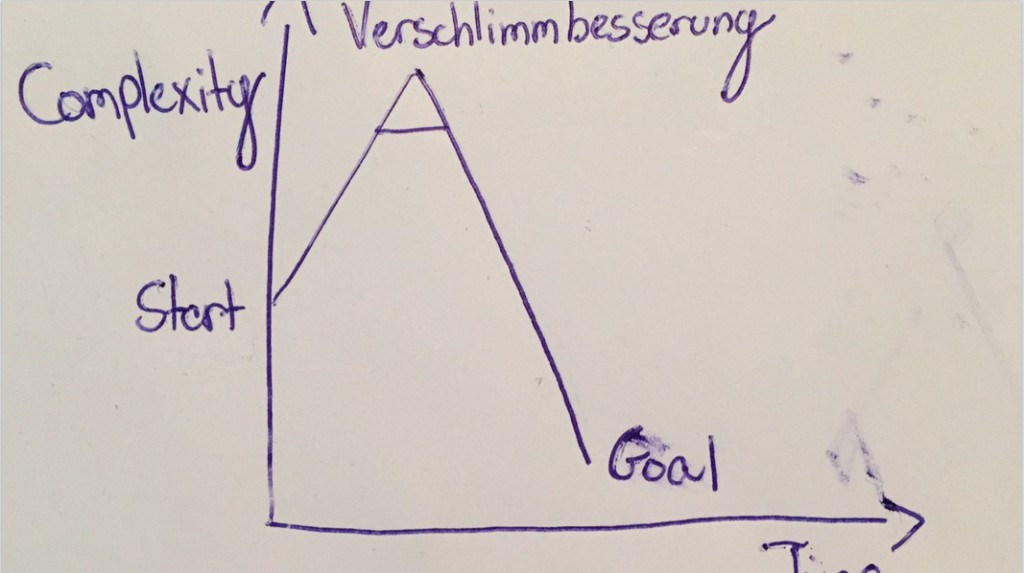Over here at NETWAYS last week was an ENGLISH WEEK and that means that all the meetings, standups, personal discussions and last but not least this blogpost (cause i wrote it last week) took place in English. Ok, to be honest there where some discussions at the restrooms and the smoking area that where still in German, but let’s say everywhere.
For most of the people over here Christmas holidays starts today and therefore I think this is a good moment to have a look on the things that will become important next year. To make it easier, I focus on a couple of things I see trending for us. Everything I write here is not the result of a survey or some official studies; it is just my personal opinion. You want to know why? Cause I can!
IaaS and Virtualization
A couple of years ago, XEN, KVM and tools to manage a bunch of hosts where really hot shit in IT. Nowadays, „nobody“ cares about the basic technology anymore and if somebody has more than four Raspberry Pis‘ he thinks about an OpenStack installation. It is straight forward, just install Nova, Neutron, Cinder, Glance, Swift and Ceilometer and you are ready to rumble. But the question is: do you really need it? Don’t get me wrong, I am not an OpenStack expert and I think if you want to provide public cloud service or if you have hundreds or thousands of machines it is definitely the way to go. But for 50 hosts in a heterogeneous environment? Really?
Since a couple of years, we have been using OpenNebula and I think it was one of the best decisions we made because it is flexible, stable, updates work like a charm and we normally don’t care about it. And last but not least, I think it is really important that solutions like OpenNebula, CloudStack or similar survive to provide an alternative.
Do I really talk about virtualization over here? Virtualization is something from the good old days. The thing you have to do today is container based virtualization. You HAVE to use Docker and if you are a real IT hipster you can have a look on Rocket. Don’t ask for the WHY, just use it. Move everything to a container, bring it to production and think about persistence later.
I am afraid you could missunstand me and I want to clarify that. I think Docker and the idea of container based virtualization is absolutely fantastic and there is and will be a big market in the future. But it is not for sure, that Docker is the right solution for you. I listened to an interesting talk from Simon Eskildsen at DevOpsDays Berlin 2014 about their experience of moving everything to Docker. His final statement: „We had problems before, but now it is even worse“.
Shopify is well known for their very modern IT and open source contributions, which tells me it makes sense to wait and see what will be next year. We (mainly Sebastian) invested a couple of weeks into Docker and Mesos and provide a one day workshop about it, because we think this is a technology of the future. But it is still very volatile and should be treated with caution. Perhaps Docker is dead next year and some other Rocket will leave our atmosphere.
Storage
We are working on kicking our NetApp out of the datacenter by the end of the month. We bought the first filer in 2008 and it really helps us to rely on a failure safe and robust architecture. A couple of months later, we added a shelf and life was great. But the demand for storage increased and therefore we needed to buy another shelf and learned the most important NetApp lesson: You „can“ add another shelf, but the CPU of the head is not strong enough (I think my first Nintendo had a stronger CPU) and the maintenance renewal would be so expensive that it makes sense to buy a new one. We did it three years ago and the migration worked out well. But time flies by and we had to renew our support again. And because of the growing demand for space and high availability, we need a second and a new one (because it is out of lifetime).
I am done with it and we started to find a replacement late last year. Our first choice was GlusterFS, because at this point it seems to be the best alternative for a NFS-Style replacement, which most of our customers need and Ceph(FS) was not good and stable enough in our opinion. So we gave GlusterFS a try and the first tests and production examples worked out well. With the increasing number of clients and GB on the storage our problems increased as well. We had a couple of situations with out-of-sync files and heavy load after an outage. At the end it was not possible to add additional nodes because the whole systems went crazy after that. We tried a lot. I had contact with developers but nobody was able to help us. This led us to Ceph this year and because of two reasons the decision was not so hard:
- We use OpenNebula and Bareos for backup and both support Ceph
- We were not able to find a real competitor
We have been running Ceph in production for months now and I think all the great (software) storage solutions out there will result in a dramatic change of the market. More and more service providers are specialized on open source storage solutions as well and it will be hard for NetApp, EMC and others to sell their products. They recognize this and provide cloud adapters and multi-tiered storage as well but they still trust in their original USP and their partners and I don’t think this will work out. Nobody is too big to fail and the named brands are far away from that. But buying racks of storage and throw them away a couple of years later is not the future. Storage is commodity and that will change the business model of selling fixed boxes.
Systems Management
This is definitely my area and probably also a danger zone, because I am not really objective. I think the Icinga project is awesome and with the new core and the upcoming web interface many things become possible. I think one of the major mind shifts the industry did in the last years is, that system management with all the „small“ things like monitoring and configuration management is not an additional component to provide IT. Now it is the foundation to provide fast, reliable and scalable services. This results in a dramatic change for monitoring as well. Monitoring is „no longer“ a subsequent IT discipline, but core services which need attention from day 1.
Taking this as fact, it is also important to understand a fundamental change in the architecture of a monitoring system. Nobody or let’s say hardly nobody needs an unified box to combine all monitoring fields like logging, event management, notification, altering, reporting and management. We need tools that integrate in the current architecture and provide interfaces to other tools specialized for certain things.
This has also a massive impact on our solutions and our service portfolio. We are confident, that it doesn’t make sense to reinvent the wheel again and again. It totally makes sense to provide an open solution and try to connect with as many tools as possible. We did and we will do so with Icinga and the current success speaks for itself. Providing an interface to Logstash, Graphite, Graylog2 and the „traditional“ monitoring add-ons like PNP4Nagios is the way to go and we’ll follow that road. Loosely coupled systems with specialization on metrics, logs or anything else, are the best and most flexible answer for high frequent changes in modern IT.
People
The biggest value you can have, and this counts more in an open source company, are the people driving your company. DevOps, DevOps, DevOps (just trying to make this SEO friendly) is a very good cultural movement in that direction and changes the way people interact and work together. DevOps is not about tools (sorry software vendors), it is about the people and their daily interaction and common way to solve problems reach the impossible and stay motivated. Putting Dev and Ops together is not the end and we’ll see more and more Q&A, project management and sales working together in teams in the future.
And if you think the idea of the cultural movement is overhyped, you might be right because of the buzzword, but not regarding the movement. Visiting traditional companies from time to time makes it clear to me, that there is a lot of work to do.
Conclusion
There is none. Pick something out if you want to or forget about it. Perhaps you think this post must be 5 years old, because you still have everything in AWS and the Senior DevOps Engineers in your company only do ChatOps with Hubot or Lita. And maybe this post doesn’t help you, but there are people out there who need more than help, they need a revolution.
Thanks to Sirupsen for the Verschlimmbesserung.



















0 Kommentare
Trackbacks/Pingbacks